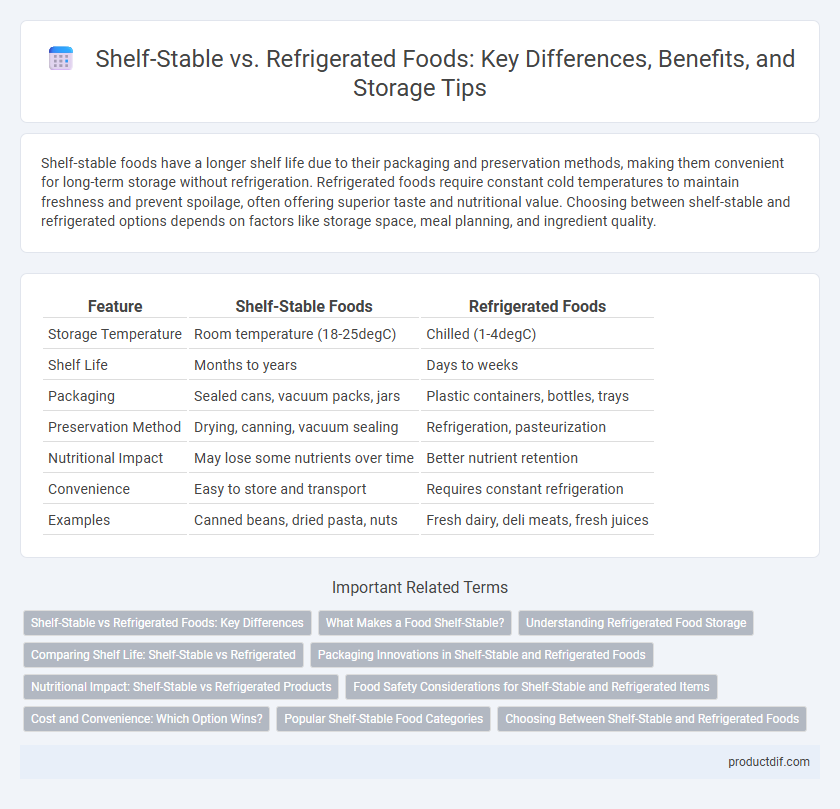Shelf-stable foods have a longer shelf life due to their packaging and preservation methods, making them convenient for long-term storage without refrigeration. Refrigerated foods require constant cold temperatures to maintain freshness and prevent spoilage, often offering superior taste and nutritional value. Choosing between shelf-stable and refrigerated options depends on factors like storage space, meal planning, and ingredient quality.
Table of Comparison
| Feature | Shelf-Stable Foods | Refrigerated Foods |
|---|---|---|
| Storage Temperature | Room temperature (18-25degC) | Chilled (1-4degC) |
| Shelf Life | Months to years | Days to weeks |
| Packaging | Sealed cans, vacuum packs, jars | Plastic containers, bottles, trays |
| Preservation Method | Drying, canning, vacuum sealing | Refrigeration, pasteurization |
| Nutritional Impact | May lose some nutrients over time | Better nutrient retention |
| Convenience | Easy to store and transport | Requires constant refrigeration |
| Examples | Canned beans, dried pasta, nuts | Fresh dairy, deli meats, fresh juices |
Shelf-Stable vs Refrigerated Foods: Key Differences
Shelf-stable foods, such as canned vegetables, dried grains, and vacuum-sealed snacks, are designed to be stored at room temperature without spoiling for extended periods. Refrigerated foods include dairy products, fresh meats, and pre-packaged meals, which require consistent low temperatures to prevent bacterial growth and maintain freshness. The key differences lie in packaging technology, preservation methods, and storage requirements, directly impacting shelf life and food safety.
What Makes a Food Shelf-Stable?
Shelf-stable foods maintain safety and quality without refrigeration due to low moisture content, acidity, and packaging that prevents microbial growth. Techniques such as dehydration, canning, vacuum sealing, and the use of natural preservatives like salt and sugar contribute to their extended shelf life. Properly processed shelf-stable items like canned vegetables, dried grains, and powdered milk resist spoilage by inhibiting bacteria, yeast, and mold.
Understanding Refrigerated Food Storage
Refrigerated food storage maintains temperatures between 34degF and 40degF to slow bacterial growth and preserve freshness, significantly extending the shelf life of perishable items such as dairy, meats, and fresh produce. Proper refrigeration reduces the risk of spoilage and foodborne illnesses by inhibiting the growth of pathogens commonly found in raw and cooked foods. Understanding optimal temperature control and regular monitoring are essential for ensuring food safety and quality in refrigerated storage environments.
Comparing Shelf Life: Shelf-Stable vs Refrigerated
Shelf-stable foods typically offer a shelf life ranging from several months to years due to packaging methods like vacuum sealing or preservatives that inhibit microbial growth. Refrigerated foods, while fresher, generally have a shorter shelf life of days to weeks since lower temperatures slow spoilage but do not stop it entirely. Comparing shelf life, shelf-stable products provide extended storage convenience, whereas refrigerated items require consistent cold environments to maintain safety and quality.
Packaging Innovations in Shelf-Stable and Refrigerated Foods
Packaging innovations in shelf-stable foods include vacuum-sealed pouches, retortable containers, and modified atmosphere packaging that extend shelf life without refrigeration by inhibiting microbial growth and oxidation. Refrigerated foods benefit from active packaging technologies such as oxygen scavengers, antimicrobial films, and smart sensors that monitor freshness and maintain optimal humidity levels. These advancements enhance food safety, reduce waste, and improve convenience across both shelf-stable and refrigerated categories.
Nutritional Impact: Shelf-Stable vs Refrigerated Products
Shelf-stable foods often undergo heat processing like pasteurization, which can reduce certain heat-sensitive nutrients such as vitamin C and some B vitamins, whereas refrigerated products typically retain higher levels of these nutrients due to minimal processing. Refrigerated fresh foods preserve enzymatic activity and nutrient content better, supporting higher antioxidant levels and bioavailability of vitamins. However, shelf-stable items provide long-term nutrient stability and convenience without refrigeration, making them essential for nutrient access during storage and transport.
Food Safety Considerations for Shelf-Stable and Refrigerated Items
Shelf-stable foods undergo thermal processing and sealing methods that eliminate pathogens, allowing safe storage at room temperature without refrigeration. Refrigerated items require consistent temperatures below 40degF (4degC) to inhibit bacterial growth and preserve freshness, with strict temperature control crucial to prevent foodborne illnesses. Proper handling and storage guidelines are essential for both categories to maintain safety and prevent contamination or spoilage.
Cost and Convenience: Which Option Wins?
Shelf-stable foods typically offer lower costs due to reduced packaging and longer storage life, eliminating the need for constant refrigeration. Refrigerated foods often demand higher energy expenses and more frequent shopping trips, impacting overall convenience and monthly budgets. Consumers seeking affordability and minimal maintenance generally favor shelf-stable options, while those prioritizing freshness may tolerate higher costs with refrigerated products.
Popular Shelf-Stable Food Categories
Canned vegetables, dried pasta, and snack crackers dominate popular shelf-stable food categories due to their long shelf life and convenience. These items maintain nutritional value without refrigeration, making them essential in emergency preparedness and everyday pantry stocking. Shelf-stable foods reduce waste and offer quick meal solutions compared to refrigerated alternatives, appealing to busy households and minimalist lifestyles.
Choosing Between Shelf-Stable and Refrigerated Foods
Choosing between shelf-stable and refrigerated foods depends on storage availability, convenience, and nutritional retention. Shelf-stable foods, such as canned vegetables and dried grains, offer long shelf life without refrigeration, ideal for emergency preparedness and limited fridge space. Refrigerated foods maintain higher freshness and nutrient quality, especially in perishable items like dairy, meats, and fresh produce.
Shelf-stable vs Refrigerated Infographic

 productdif.com
productdif.com